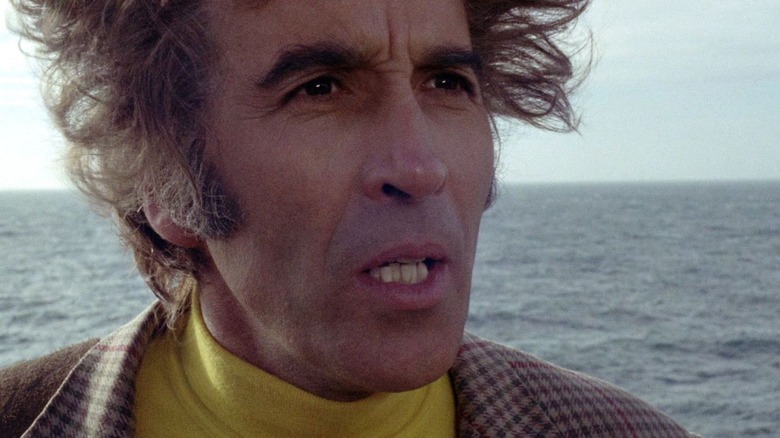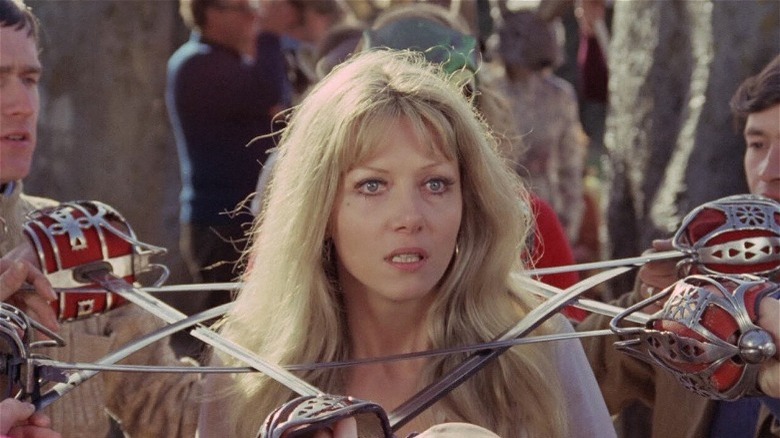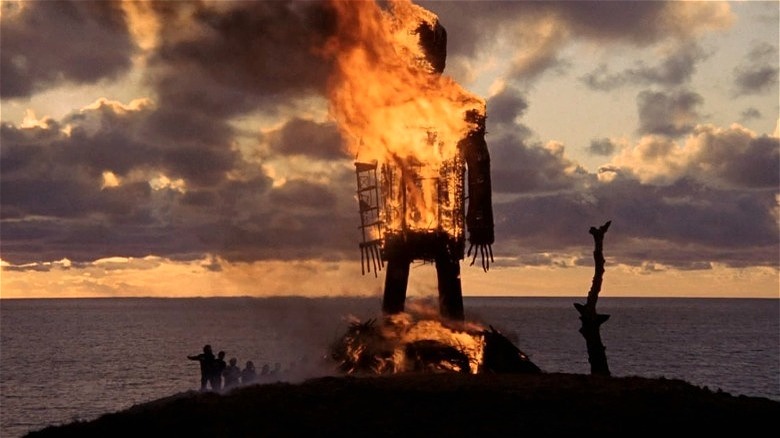The Wicker Man's Surreal Soundtrack Was A Product Of Studio Stinginess
In the 1973 British folk horror film "The Wicker Man," Lord Summerisle (Christopher Lee) and the inhabitants of his island break into song and dance while they burn a police officer alive inside a wicker effigy. This ritual sacrifice scene is extremely unsettling: a horrific crime is committed against the backdrop of upbeat folk tunes, marking the beginning of a new harvest season for the islanders. While the commune continues singing, the man inside the wicker effigy screams in agony — a terrifying combination that helps create a haunting soundscape that elevates the film's final moments.
The surreal, otherworldly soundtrack of "The Wicker Man," which clearly emerges as one of the film's many strengths, came into being in a rather unusual way. The tracks were recorded even before filming began but managed to perfectly capture the essence of a tale mired in pagan rites and the concept of the "other." Paul Giovanni, who composed and arranged the soundtrack for the film, worked alongside an impromptu band named Magnet, whose members came together solely for this project. Instead of approaching trained musicians, Giovanni and Magnet worked with music students and cast members, who ended up performing several folk songs on the soundtrack.
However, this eccentric way of going about the soundtrack was not a deliberate artistic choice by Giovanni and co. The studio behind "The Wicker Man," British Lion, rushed the project on all fronts, which forced everyone on board to make do with the cheapest options available to them at the moment. The same was true for those working on the film's soundtrack, who had to create and record everything with a limited budget and talent pool.
The Wicker Man was criminally underestimated by its studio
The influence of "The Wicker Man" soundtrack on contemporary folk musicians and horror film soundtracks cannot be overstated. Soundtrack aside, the film itself acted as the original blueprint for the folk horror genre, spawning several premises that modeled themselves on Robin Hardy's film. Take Ari Aster's daylight horror, "Midsommar," as an example: the film pays direct homage to the 1973 film, and its final shot is an effective variation of the wicker burning ritual. Other films, such as "Apostle," mimic the tropes in "The Wicker Man" in overt, brutal ways. Meanwhile, the 2006 remake of the 1973 original is disastrously terrible for many reasons.
While "The Wicker Man" has emerged into a cult classic over the years, British Lion failed to appreciate the innate value of the film at the time. In an interview with The Guardian, musical director Gary Carpenter explained how the studio rushed production and cut costs, making the process difficult for those involved with the soundtrack:
"British Lion wanted the film to be made quickly and cheaply, with students playing the music to save money. But the Royal College of Music blocked this, saying it would be too disruptive and time-consuming for its students. So they looked at recent graduates instead – and that was me. I was invited to meet Paul Giovanni, who wrote the songs...I told him I could get people who knew about folk music and were cheaper than his first choice, Pentangle."
With the focus being shifted to availing the cheapest talent with a basic background in folk music, Giovanni and Carpenter worked haphazardly to create a sound that suited the film's aura. The idea was to create a "semi-mystical occult" soundscape that borrowed from Celtic and Irish folk musical traditions. Surprisingly, it worked.
The Wicker Man's soundtrack still holds power
Giovanni and Magnet created something that spoke to various subcultures and subgenres in art. David Colohan, who spearheads the "new weird" movement with his band, United Bible Studies, spoke in depth to The Independent about the influence of the film's soundtrack. Coholan posts that it was unusual how an American songwriter and an impromptu British band managed to collaborate under such restrictive conditions and created a haunting soundtrack that features "Middle English chants, rowdy pub singalongs, erotic ballads, psychedelic guitar solos, and creepy nurses rhymes."
Circling back to Carpenter's interview linked above, the musical director said that certain scenes had to be shot in sync with the music, a tedious endeavor that took hours to perfect. Per Carpenter, one of the film's most memorable sequences, in which Willow (Britt Ekland) attempts to seduce the policeman while dancing to a folk song, took 13 hours to shoot. Carpenter had to hit a drum rhythmically to help Ekland sync her movements to the folk song. "Willow's Song" still remains as beautiful and unsettling as ever, and the scene cements the dream-like nature of the narrative.
To this day, "The Wicker Man" soundtrack is a source of inspiration for pagan musicians, avant-garde Scottish electro music, and the New Weird scene. Aspects of this sound have been replicated in HBO's island horror, "The Third Day," in which Florence + The Machine's tracks are used to evoke a sense of hopeless doom. In essence, folk horror offerings owe a massive debt to "The Wicker Man," a film that was able to break the mold in spite of the practical limitations that threatened to strangle its very existence.


